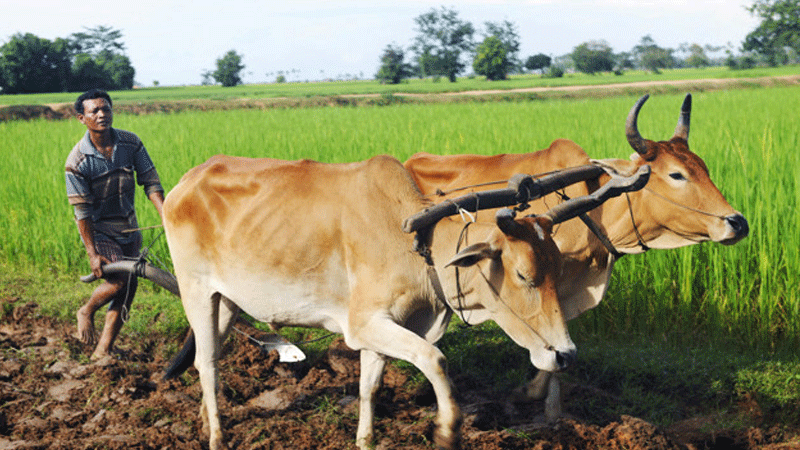What is PMFBY ?
For an effective solution to the agrarian crisis, Prime Minister Shri Narendra Modi has introduced many schemes and obliterated the weaknesses of previous schemes since he came to power in 2014. Among those schemes and initiatives, the Prime Minister’s Fasal Bima Yojana (PMFBY) has a far-reaching impact on agrarian society was launched in 2016 for widely insurance coverage of crops. Through this scheme, Prime Minister Shri Modi has tried to overcome the challenges that were obstacles to protecting the economic interests of hardworking farmers. As a result, the scheme is proving to be helpful in reducing the risks in agriculture that are associated with natural calamities. Generally, it is seen that crops are affected by sudden floods, cyclones, heavy and untimely rains, unreasonable snowfalls, attacks of disease etc. In such circumstances, PMFBY provides insurance coverage for the crop.
We have made the crop
insurance scheme more
effective. Changed the
old rules so that more and
more farmers can get easy
compensation at the time
of disaster.
-Narendra Modi
What is the aim of PMFBY?
PMFBY is the largest insurance scheme in terms of farmer participation in the world, and it is the third-largest scheme in terms of premiums. The aim of the Modi government is to give coverage benefits under this scheme to the maximum number of farmers. With this objective, the government provides a comprehensive risk solution at the lowest uniform premium across the country for farmers. Making it more inclusive, risk coverage is being provided from pre-sowing to post-harvest losses.
For the fiscal years 2021–22, the Union government allocated 16,000 crores for PMFBY. This allocation was 305 crore more than the previous allocation in the budget. Through the increased allocation, the government intends to make insurance coverage more extensive.
How will the farmer get his claim ?
Through eradicating unnecessary bureaucratic hurdles, the Modi government made it easier for farmers to access the scheme through the use of information technologies. Under the scheme, farmers can report crop loss within 72 hours of the occurrence through the Crop Insurance App, common service centres, or the nearest agriculture officer. A claimed benefit is then provided electronically into the bank accounts of eligible farmers. Integration of land records with the PMFBY portal, the Crop Insurance mobile app for easy enrollment of farmers, and usage of technology such as satellite imagery, remote-sensing technology, drones, artificial intelligence, and machine learning to assess crop losses are being used to provide quick and easy access to the benefits of the scheme.
For execution and creating a database, the government of India has designed and developed a National Crop Insurance Portal (NCIP) (www.pmfby.gov.in). The insurance portal has brought in better administration and coordination amongst farmers, states, insurers, and banks, as well as ensured real-time dissemination of information and transparency in implementation. The portal was brought into operation in 2018. Since the operationalization of the portal, the State Government has migrated to NCIP for better coordination. According to a release by the government, over 5.5 crore farmer applications are received on a year-on-year basis.
Revamping the scheme in 2020, the scheme was made voluntary for farmers. When it was launched in 2016, it was non-voluntary. It was mandatory for those availing of crop loans from banks. Now, it is not mandatory for those farmers who are availing of agriculture loans. From now on, the scheme is optional for all farmers, including non-loanee farmers and other farmers.
What type of risk is being covered under the scheme?
The basic coverage under the scheme covers the risk of loss of yield to a standing crop (sowing to harvesting). This comprehensive risk insurance is provided to cover yield losses on an area-based approach basis due to non-preventable risks like droughts, dry spells, floods, inundation, widespread pest and disease attacks, landslides, natural fires due to lightening, hailstorms, and cyclones.
Aside from the mandatory basic cover, state governments or UTs may choose any additional coverage based on the needs of the specific crop/area in their state in consultation with the State Level Coordination Committee on Crop Insurance (SLCCCI).
What are the major achievements of the scheme during the last five years ?
According to data released by the government during the last five years, over 29 crore farmer applications have been approved. From Kharif 2016 till Rabi 2020-21, a total of 29.16 crore farmer applications (including 68% loanee farmer applications and 32 % non-loanee farmer applications) have been approved under the scheme. More than 1 lakh crore were given in compensation under Prime Minister FasalBimaYojna, whereas premium received was just 21 thousand crores.
Of the budget provision of Rs. 16000 crore, Rs. 9719.24 crore has been utilized during 2021-22. During Kharif 2021, a total of 484.6 lakh farmer applications have been enrolled over an area of 244.7 lakh ha. for a sum insured of Rs. 99368 crore. Out of the partial claims of Rs. 11148 crore for the year 2020–21, claims of Rs. 10385 crore have already been paid to 110.7 lakh farmer applications.
PMFBY in a nutshell
PMFBY is a step towards achieving Aatmnirbhar Bharat. By reducing the risk, the scheme is instilling confidence in farmers for continuance in farming. Farmers are showing interest in adopting innovative and modern agriculture practices. In a nutshell, it is helpful in achieving the goal of doubling the farmers’ income.


